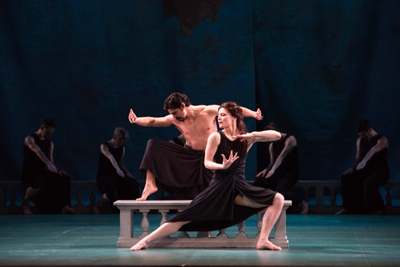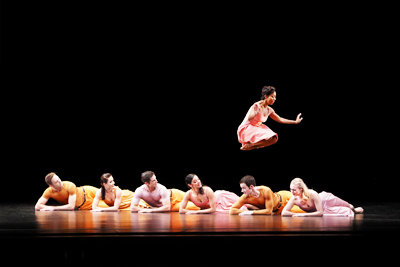Dance: Winter Memories
By Dawn Lille
arttimesjournal May 29, 2017
This past winter dance in NYC was as full of opportunities for watching as ever. Although each performance leaves the viewer with a different outlook or feeling, a few stand out.
 “Moves” NYCB —choreographer Jerome Robbins |
In recent years there seem to have been more evenings at New York City Ballet devoted to the work of Jerome Robbins. One all-Robbins program included The Concert, Glass Pieces and Moves. The last, a ballet danced in complete silence, was created in 1959. The “music” comes from the sound of the dancers’ feet and from body claps. The performers’ inner feelings of rhythm, created largely by the movements, convey a sense of hearing through seeing.
This work is made even more interesting because it came from a man who heard every rhythm and counter rhythm in music. He also had great faith in the human body.
The Concert, to Chopin’s piano music, is a movement rendering of what goes on in the imagination of audience members at a music concert. It remains funny even after multiple viewings. Robbins’ sense of humor and his inbred sense of jazz (even when the accompaniment is by Chopin) remain unmatched.
Glass Pieces, to Philip Glass’s compositions, picks up on the repetition and buildup of rhythms via movement patterns. One dancer becomes three, who become six, who become twelve, who become a huge cast differentiated by simple costumes of different colors. There is one remarkable duet in dim lighting with a row of dancer silhouettes behind. Here Robbins’ mastery of form is obvious and his ability to have dancers enter and exit unseen is still a mystery.
One March weekend in particular stands out. On Saturday evening the Mark Morris Dance Company filled the BAM opera house and on Sunday the Paul Taylor American Modern Dance company was the star at Lincoln Center.
Morris, who happily basks in the light of sometimes being called the “bad boy” of modern dance, includes among his talents a musicality that not only interprets music scores in dance, but opera as well. His program, titled Mark Morris: Two Operas, was an evening of Curlew River by Benjamin Britten and Dido and Aeneas by Henry Purcell, both directed and conducted by him. Live music for both was played by the Mark Morris Dance Group Music Ensemble.
 Guillermo Estrada, Jr. and Laurel Lynch as the hero and heroine of Mark Morris’s production of Henry Purcell’s “Dido and Aeneas”Photo: Nan Melville |
This was the New York premiere for Britten’s 1964 “parable for a church performance,” based on a medieval Japanese Noh play about a mother grieving for her lost child. The cast includes a madwoman (the mother), sung by Isaiah Bell, a ferryman, the spirit of the dead boy, pilgrims and their leader. Since Britten transferred the setting to a medieval English church where monks reenact the story, the entire cast is male and none were dancers.
This did not stop Morris who, as both director and conductor thinks like a choreographer, from relating the oral to the visual. His simple movement patterns for the singers used uncomplicated repetitive movements and spatial designs, influenced by the minimalist technique of Noh drama, that drew the audience into the action. The excellent singers and musicians gave a sense of reality to the parable.
The opera Dido and Aeneas was composed in 1689 and has a cast of eight, supported by a chorus representing different characters. Morris’ version was first presented in 1989 in Belgium and each sung role has its danced counterpart.
The eight scenes tell the story of the Trojan Aeneas, whose destiny is to found Rome, and his obsession with the young widow Dido, Queen of Carthage. An evil sorceress wishes to separate the lovers and destroy him. She enlists a bevy of witches and a false Mercury to convince Aeneas to leave Carthage and Dido, who kills herself as a result.
For this performance of the tale of love, sex and destiny, Laura Lynch danced both Dido and the sorceress, a role Morris once reserved for himself. Stephanie Blythe sang both parts. The drama in the dance is between these two, although the real question seems to center on the battle between one’s personal desires and what is best for the world.
Dido’s court is formal in the baroque sense and sad; the sorceress is surrounded by seemingly happy chaos. Yet they could be two sides of the same person. The dancers, in both dress and movement, suggest a Greek chorus.
Morris hears the intricacies and drama in the music and makes them into dance. His conducting seems to be the result of feeling the tempi in his own body. His use of specific gestures to portray the words in the libretto – a mixture of American sign language and Indian mudras expanded into dance - somehow works.
The following day Paul Taylor American Modern Dance gave a matinee performance of two Taylor works and a new piece by Lila York plus a special late afternoon program in conjunction with the American Dance Festival. All had live music.
 The Taylor Dancers in “Esplanade” The Taylor Dancers in “Esplanade” |
Continuum, York’s ballet to music by Max Richter, used fourteen dancers in a smoothly moving work that, in style, was strongly influenced by Taylor. This is not surprising since she is an alumna of the company, but she knows her craft. Of the two Taylor pieces, Esplanade (1975), to two violin concertos by J.S. Bach, is one in which the knowing audience sits back with a contented sigh and prepares to enjoy a masterpiece of runs, walks and jumps for nine dancers. It is both joyful and sad, but it is mostly about the power of dance.
The special program contained three pieces: Diversion of Angels, choreographed in 1948 by Martha Graham to music by Norman Dello Joio and performed by the Taylor dancers, Summerspace, created in 1958 by Merce Cunnigham to a score by Morton Feldman, with design and costumes by Robert Rauschenberg, danced by the Lyon Opera Ballet, and Taylor’s Promethean Fire (2002) to music of J.S. Bach.
This was a history-making program, with many thanks due to whomever thought of it – three great works by three giant American choreographers of the 20th century! It is hoped that the Taylor company, with its exciting dancers, will continue to build a repertory of notable American modern dances and to commission new ones. It is very able to dance works by other choreographers. Inviting another company adds interest as well.
dawnlille@aol.com
